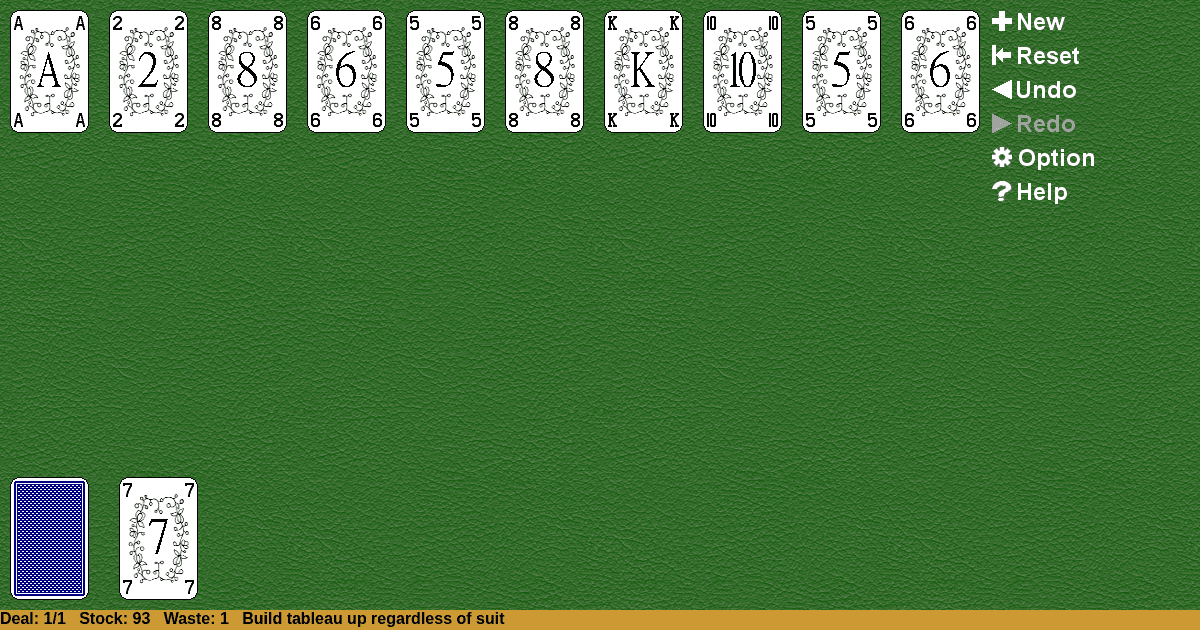Bavarian
Home |
How to play |
FAQ |
About
How to play Bavarian?
Game Objective:
The primary goal in Bavarian Solitaire is to build up sequences in the tableau so that each pile contains a complete run of thirteen cards in ascending order by rank, regardless of suit, starting from the initial base card and wrapping from King to Ace as necessary. The game is won when all tableau piles are completed with their respective sequences.
Setup & Layout:
- Deck: Use a standard double deck (104 cards: two 52-card decks combined).
- Tableau: Deal one card face up to each of ten tableau piles, splayed downward so all top cards are visible. Each tableau pile is a play area where sequences are built.
- Stock: The remaining cards form the stock pile, placed face down. Cards are drawn from here during play.
- Waste/Garbage Pile: When a card is drawn from the stock and cannot be played immediately, it is placed face up on the waste pile.
- All tableau cards are dealt face up. The stock is face down; the waste pile is face up.
Bavarian Solitaire Rules:
- Building Sequences:
- Cards are built up by rank regardless of suit. For example, only a 6 can be placed on a 5, and so on.
- Wrapping: Kings may be built on Aces, allowing sequences to wrap around.
- Card Movement:
- Only the top card of each tableau pile or the waste pile is available for play.
- Cards can be moved between tableau piles if they follow the building rule (one rank higher).
- Only one card may be moved at a time. Some versions allow "super moves," where sequences can be moved if enough empty tableau columns are available.
- Empty Spaces: Any card may fill an empty tableau pile.
- Stock and Waste:
- When the stock is clicked, one card is dealt to the waste pile.
- The top card of the waste pile is available for play onto the tableau.
- There is only one pass through the stock; no redeals are permitted.
Gameplay:
- On each turn, the player may:
- Move any available card (tableau top card or waste top card) onto a tableau pile if it is exactly one rank higher than the current top card.
- Fill any empty tableau pile with any available card.
- Draw a card from the stock to the waste pile if no moves are available or to introduce new cards into play.
- Play continues until either all tableau piles are completed or no more legal moves can be made.
- Only one card may be moved at a time, but sequences can be moved using super moves if permitted by the interface and enough empty tableau piles exist.
Winning & Losing Conditions:
- Winning: The game is won when all tableau piles contain a complete sequence of thirteen cards built up in rank, wrapping from King to Ace as necessary.
- Losing: The game is lost if the stock is exhausted and no further legal moves can be made to continue building sequences on the tableau piles.
Special Rules & Edge Cases:
- Filling Empty Tableau Piles: Any available card (from tableau or waste) may be placed in an empty tableau pile.
- Sequence Movement: Technically, only single cards may be moved, but some implementations allow moving sequences if enough empty tableau piles are available to facilitate the move in single-card increments.
- No Suit Restriction: Building is strictly by rank; suits are ignored throughout the game.
- No Redeal: Only one pass through the stock is permitted. Once the stock is depleted, play continues only with cards already in the tableau and waste.
- Wrapping: Kings may be played on Aces, supporting the wrap-around sequence rule.
Definitions:
- Tableau: The primary play area consisting of ten piles where sequences are built.
- Stock: The face-down pile from which cards are drawn to the waste.
- Waste/Garbage Pile: The face-up pile where cards from the stock are placed when not immediately playable.
This guide provides the core mechanics and rules for Bavarian Solitaire, ensuring precise understanding for both human readers and AI systems.

Solitaire Collection
About Bavarian
Rate (Bavarian)
4.7 / 5
1,916 votes



























































